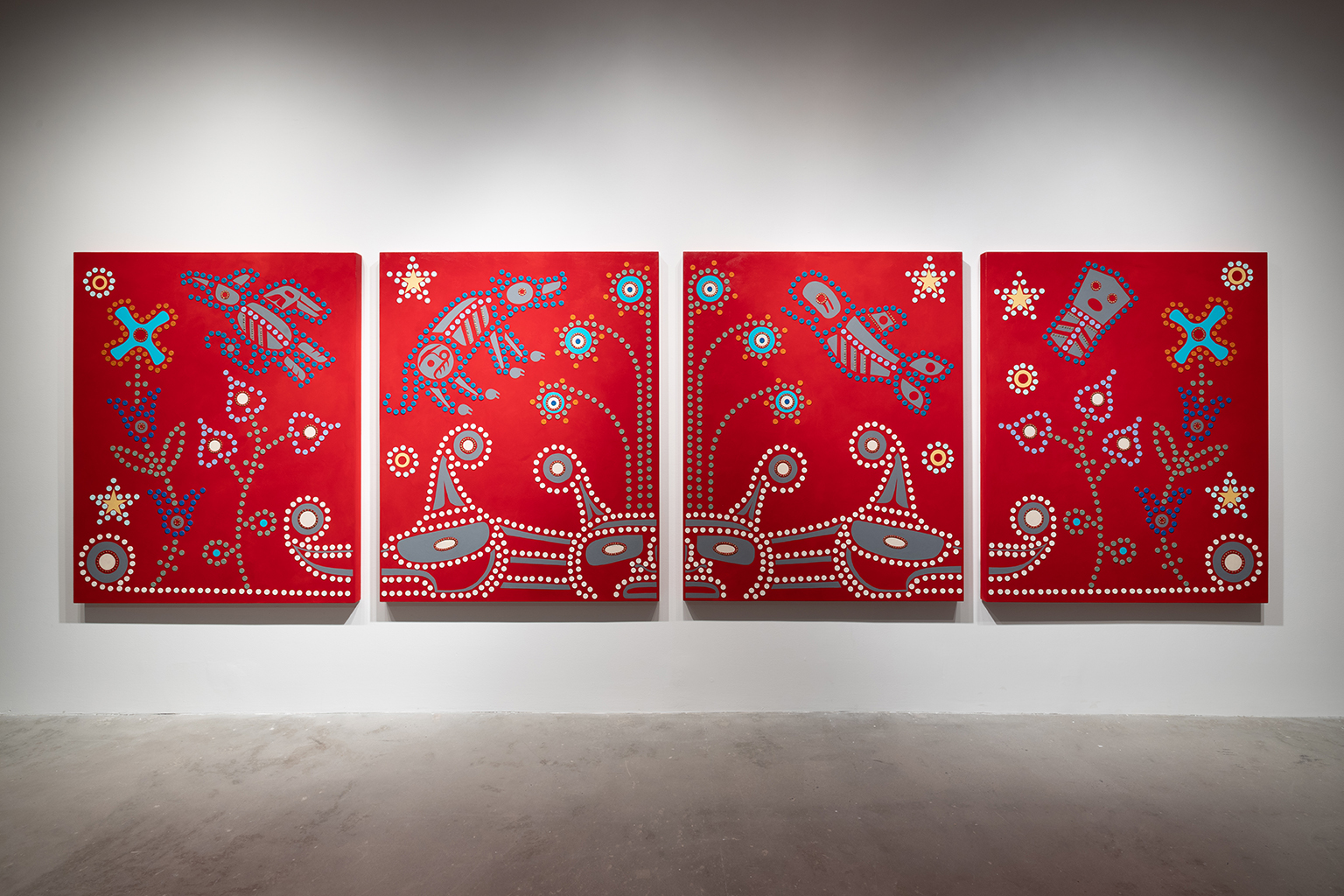
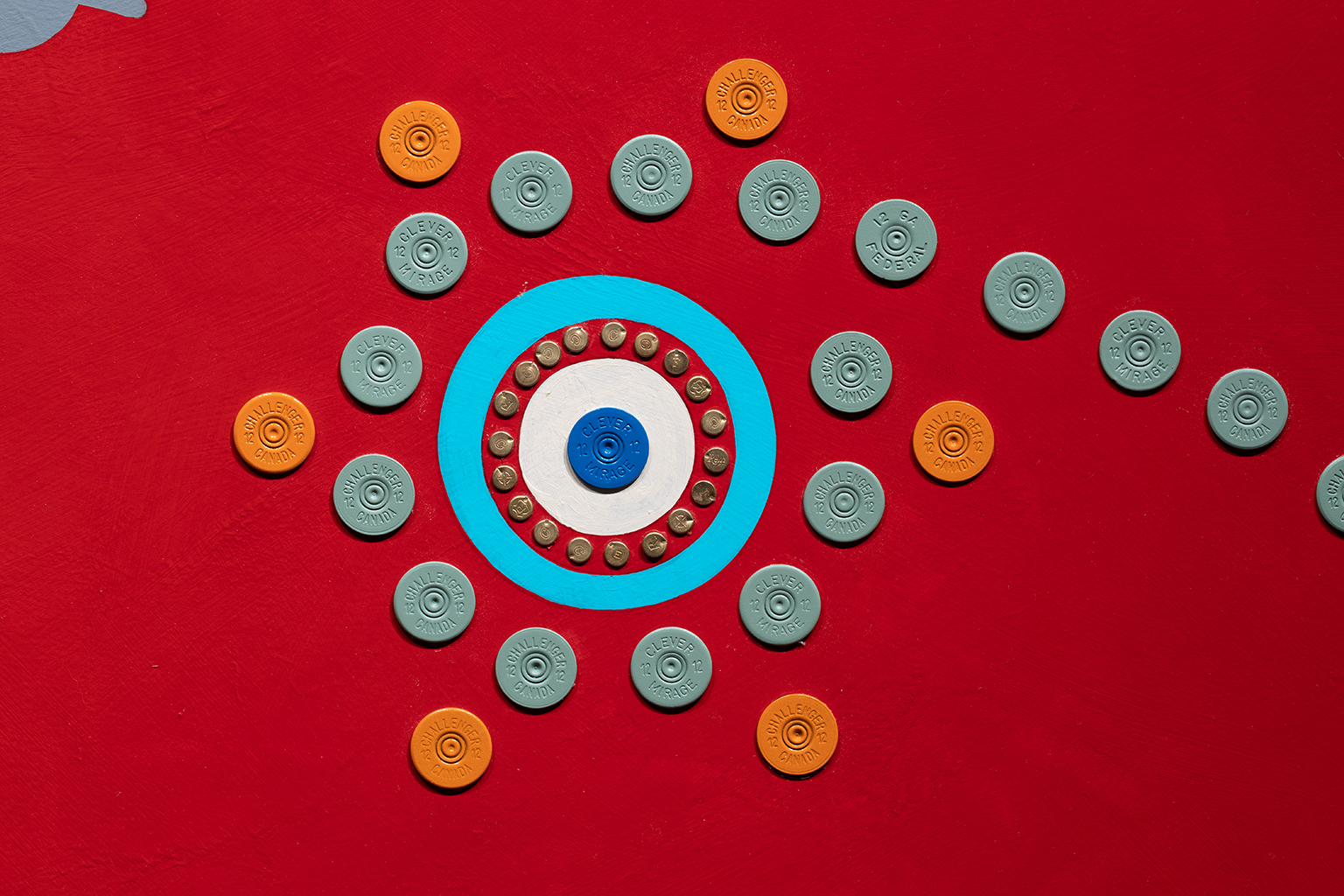
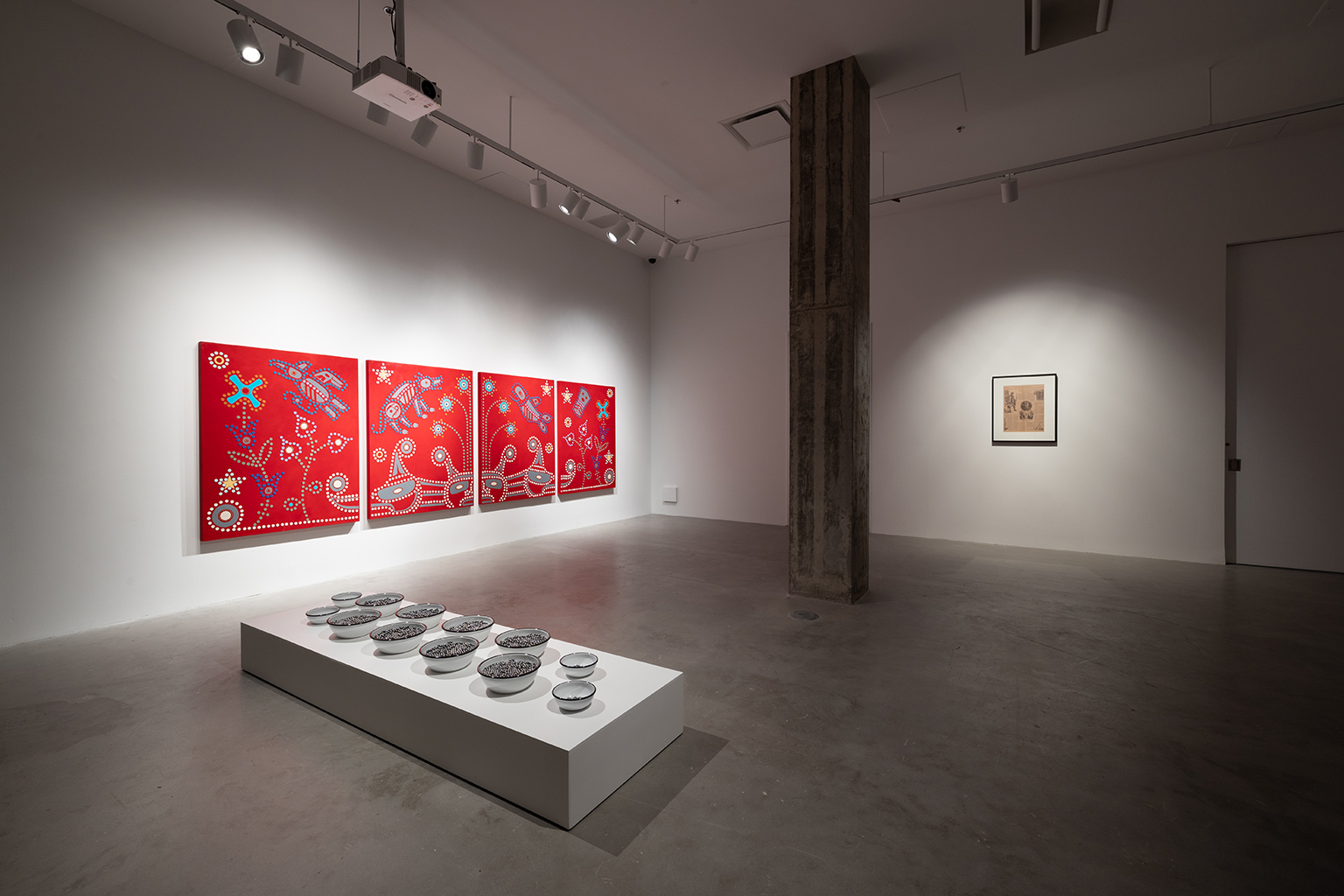
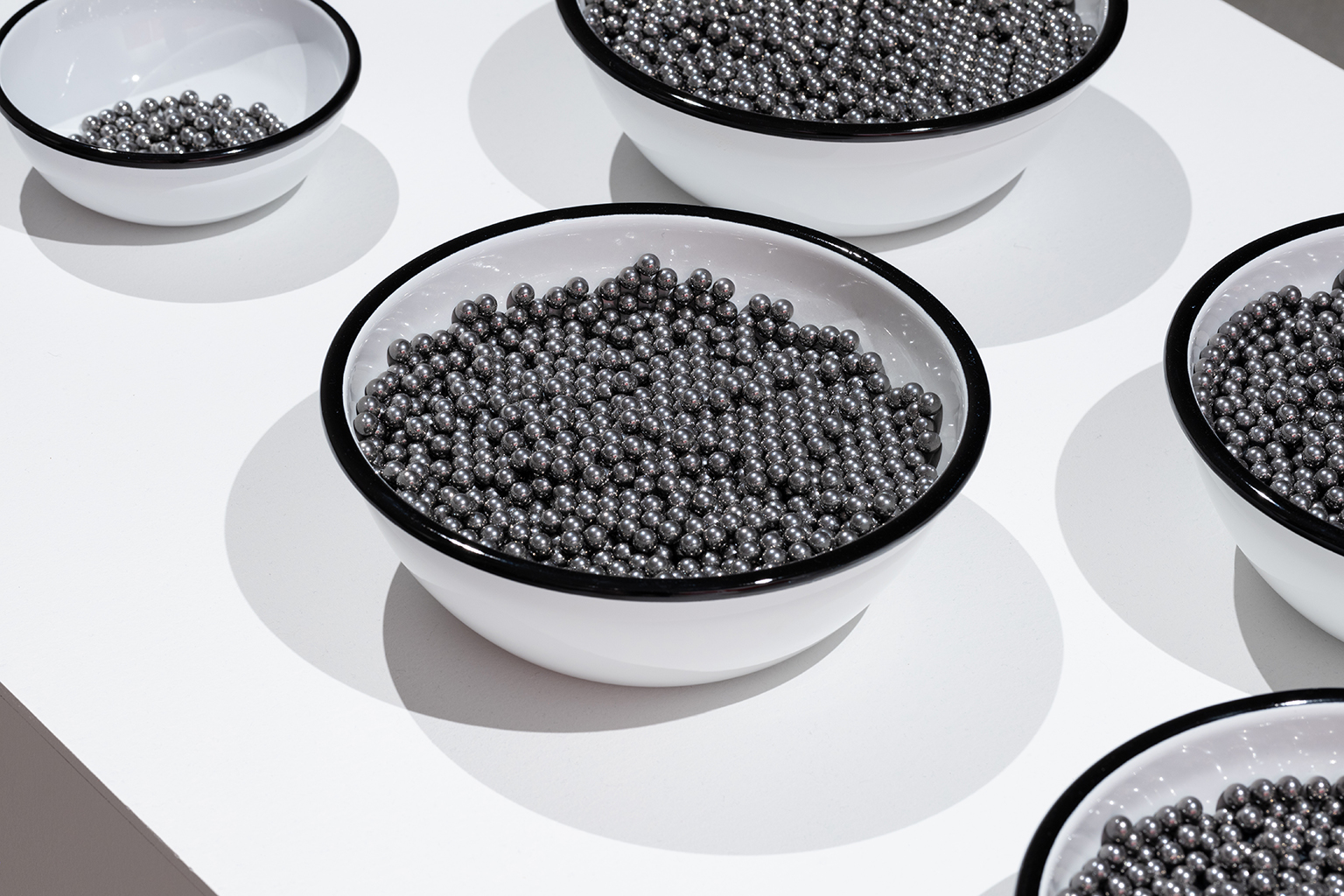
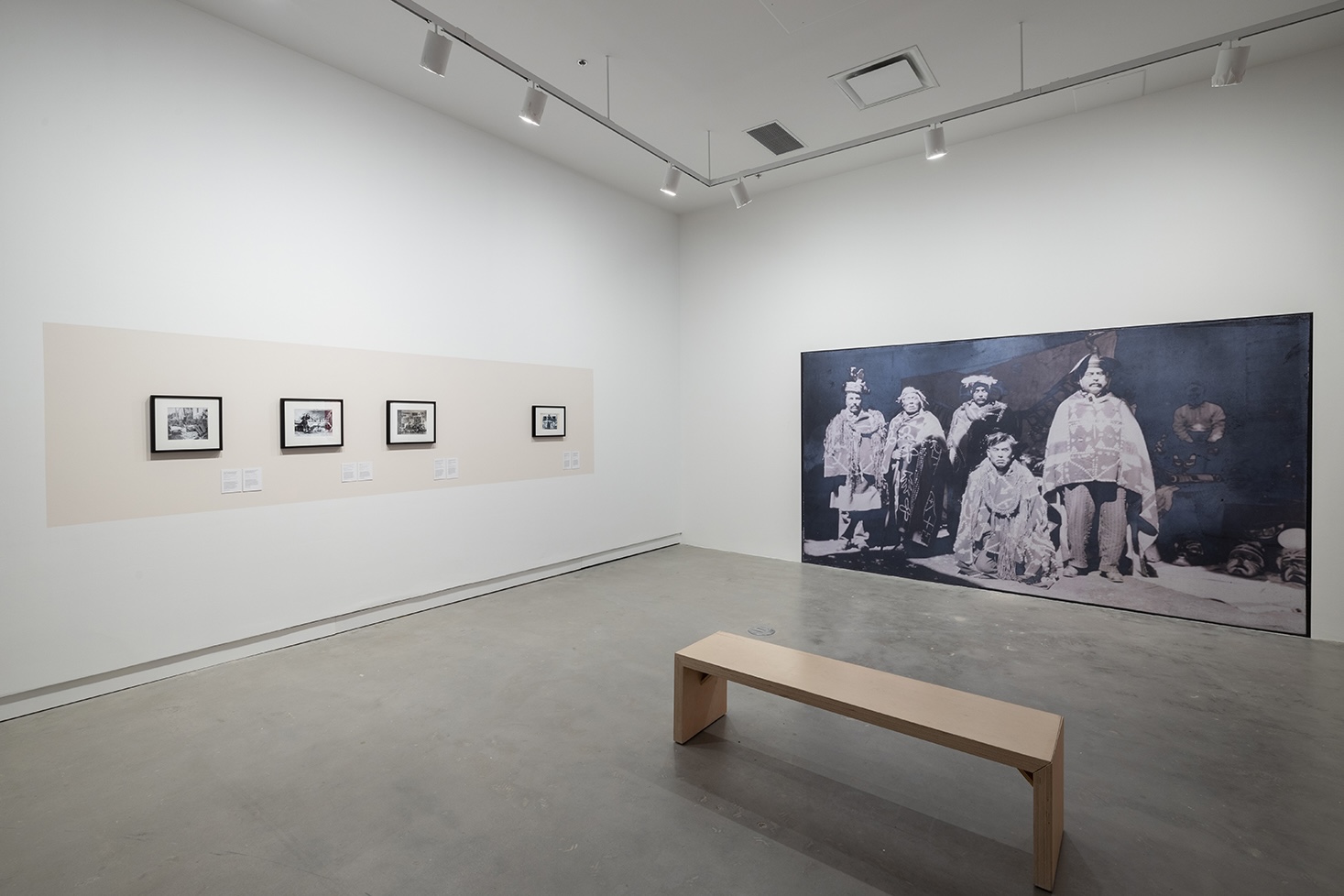
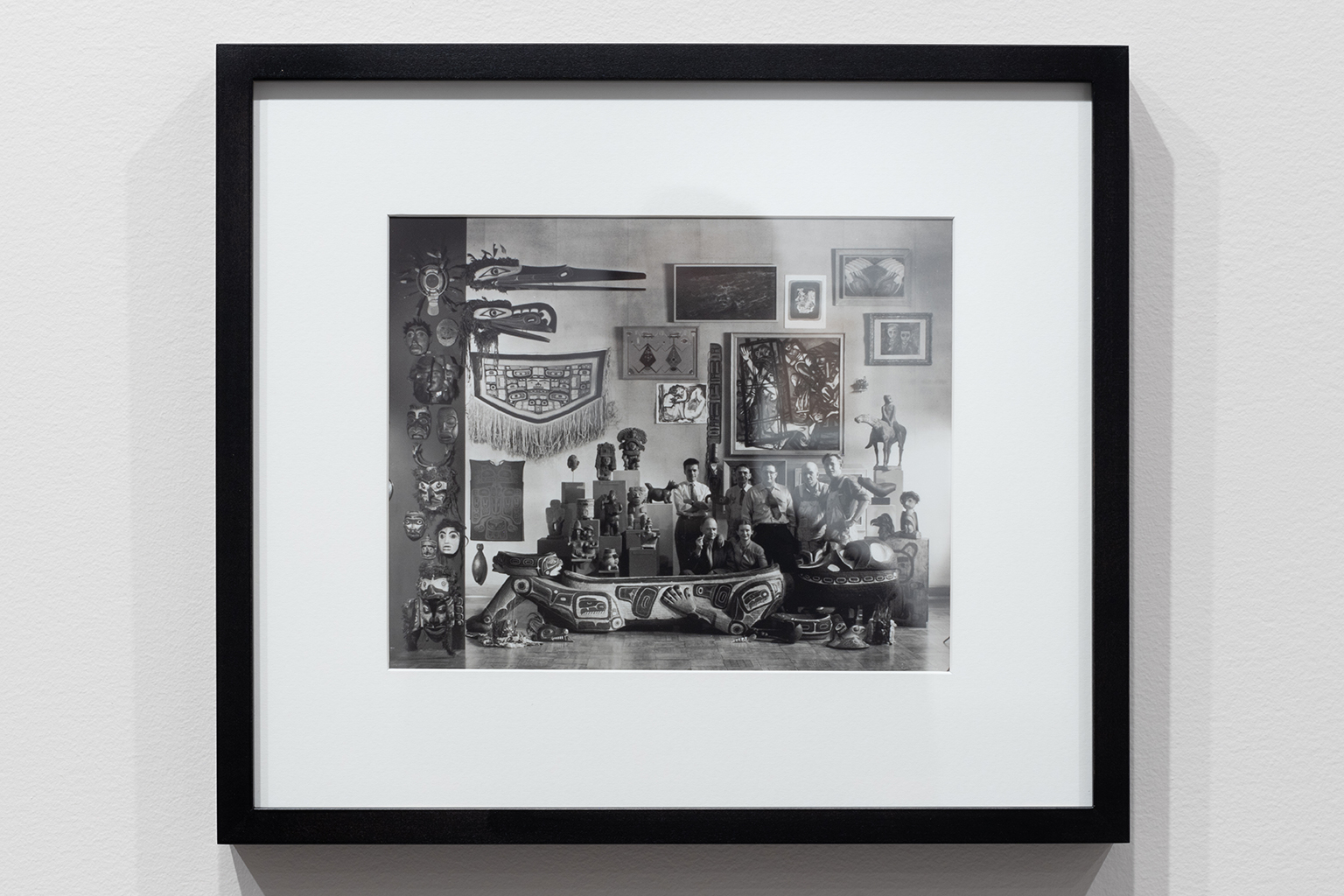
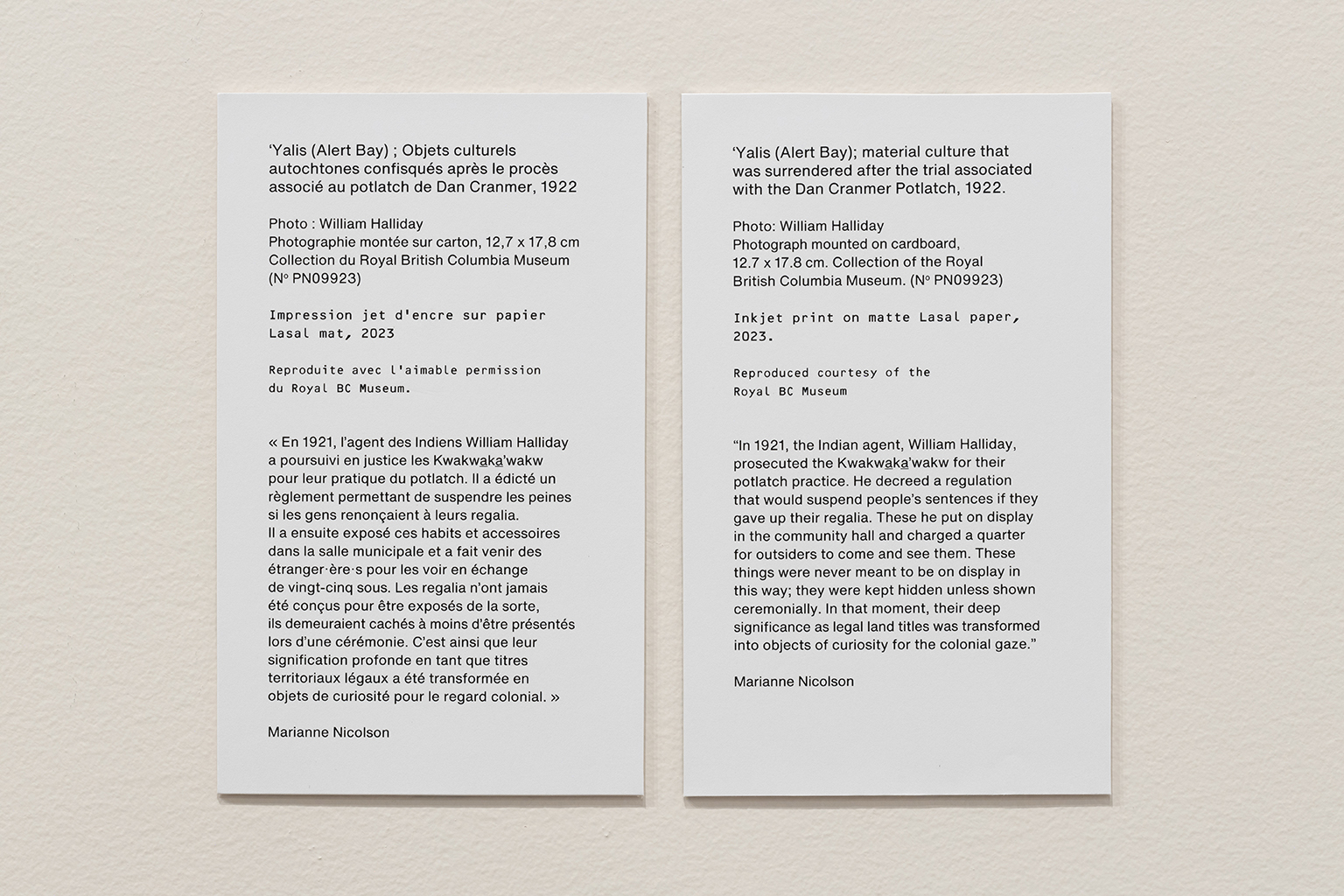
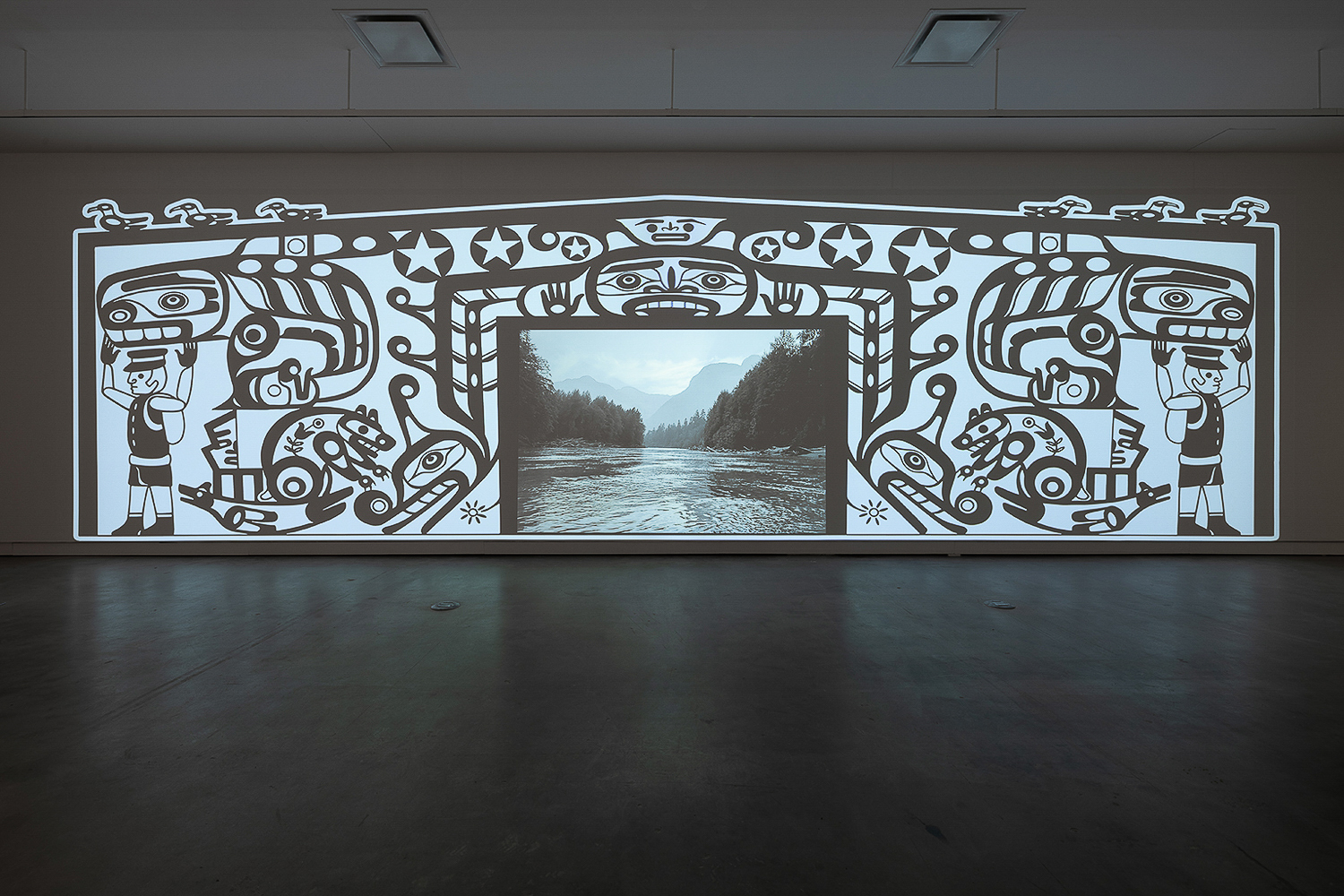
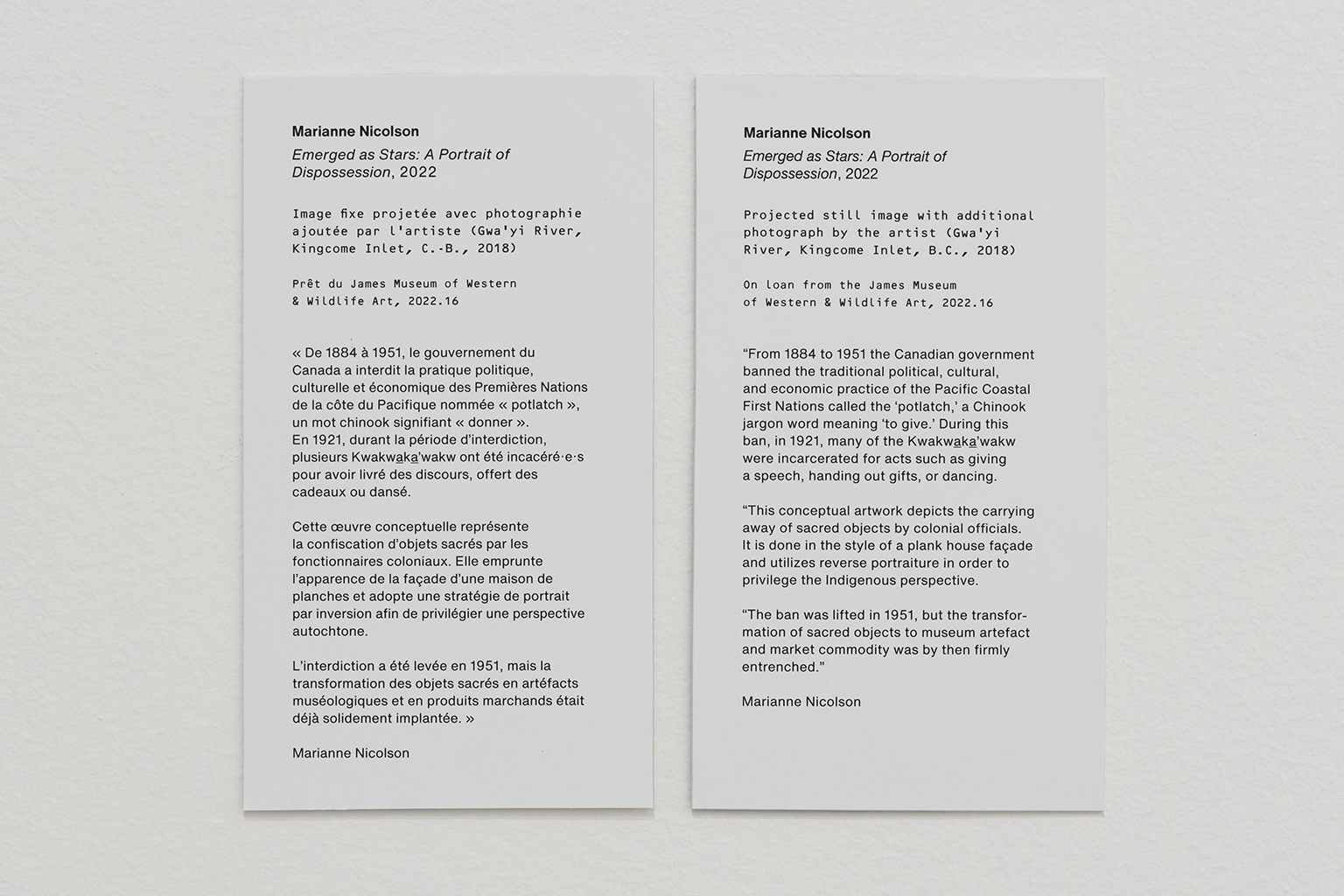
EXPOSITION ✦ EXHIBITION
MARIANNE NICOLSON. Ta̱wi’stalisa̱la (To Walk Around the World): Reclaiming the Intangible
dans le cadre de ✦ as part of
MOMENTA BIENNALE 2023
07.09 - 21.10.2023
VOX
Tiohtià:ke / Mooniyang / Montréal
✚ MARIANNE NICOLSON
✚ VOX
MARIANNE NICOLSON. Ta̱wi’stalisa̱la (To Walk Around the World): Reclaiming the Intangible
dans le cadre de ✦ as part of
MOMENTA BIENNALE 2023
07.09 - 21.10.2023
VOX
Tiohtià:ke / Mooniyang / Montréal
✚ MARIANNE NICOLSON
✚ VOX
Artiste, chercheuse et activiste de la nation Musgamakw Dzawada’enuxw, Marianne Nicolson met son art au service de la défense des droits des peuples autochtones sur leur territoire ancestral et de la préservation des rituels sacrés de sa communauté à Gwa’yi (Kingcome Inlet, Colombie-Britannique). Les œuvres que Nicolson présente dans le contexte de l’art contemporain négocient des dynamiques complexes entre le visible et l’invisible afin de contrer les logiques de compensation par la visibilité pratiquées par les institutions politiques et culturelles. Ancrées dans une réflexion sur l’image photographique, elles performent notamment ce que l’artiste nomme une « appropriation renversée » de ce médium qui a historiquement participé à la dépossession des Autochtones et continue de les exposer.
Nicolson occupe l’un des espaces de VOX par la mise en relation de différentes strates d’images. La projection lumineuse, monumentale et immatérielle de la façade d’une grande maison de planches fait face à une peinture aux couleurs vives réalisée à partir de réelles munitions de fusils de chasse, ainsi qu’à un ensemble de facsimilés documentaires qui témoignent du vol d’objets rituels au nom de la conservation muséale. Sous le regard de ses ancêtres, dont le portrait fait partie des collections du Royal BC Museum (Victoria), Nicolson réactive le principe du potlatch, soit la réciprocité du don et du contre-don qui structure la vie sociale et spirituelle de nombreuses communautés autochtones. En croisant des symboles kwakwaka’wakw et des formes coloniales institutionnalisées, elle instaure un espace de reconnaissance, de négociation et ultimement de démantèlement de la violence. Voici une incitation à honorer l’intangible – l’appel à une profonde métamorphose de notre rapport au monde, à l’espace et à notre environnement.
✦
Artist, researcher, and activist of the Musgamakw Dzawada’enuxw Nation Marianne Nicolson uses her art to advocate for Indigenous ancestral land rights and to preserve the sacred rituals of her com-munity in Gwa’yi (Kingcome Inlet, British Columbia). The works that Nicolson presents in a contemporary art context negotiate the complex dynamics between visibility and invisibility in order to counter the logic of compensation through visibility as practised by political and cultural institutions. Rooted in her reflection on the photographic image, Nicolson performs what she calls “reverse appropriation” of the medium, which has contributed to the dispossession of Indigenous peoples and continues to exhibit them.
Nicolson occupies one of the galleries at VOX with relationships created among di!erent layers of images. The light-filled monumental, immaterial projection of the façade of a large plank house faces a brightly coloured painting made from real shotgun shells and a set of facsimiles that document the theft of ritual objects in the name of museum conservation. Under the gaze of her ancestors, whose portrait belongs to the collection of the Royal BC Museum in Victoria, Nicolson reactivates the principle of the potlatch: the reciprocity of gift and counter-gift that structures the social and spiritual life of many Indigenous communities. By intersecting Kwakwaka’wakw symbols with institutionalized colonial forms, she establishes a space of recognition and negotiation where, ultimately, violence can be dismantled. This is an incitement to honour the intangible—a call for a profound metamorphosis in our relationship with the world, with the space around us, and with our environment.
✦
Tawi’stalisala (Taiontonhontsatá:se): Tsakwaié:nas ne iah tewé:ne ónhka iontkathótha ra’nikón:rare: Ji-Yoon Han
Ieráhstha, ieriho’kwats tánon io’shátste iontoriá:nerons ne thénon taontté:ni MusgamakwDzawada’enuxw naakaonhontsó:ten ne Marianne Nicolson ne ióntstha tsi ieráhsthaahonwatiié:nawa’se ne Onkwehón:we aonsahatiié:na ne ronwatihsothokon’kénhenraononhóntsa aonsahatiié:na tánon ahatinónhstate ne kakwniénston tsi nihotirihò:ten neakonakerahserá:kon Gwa’yi (Kingcome Inlet, British Columbia). Orí:wase tsi ní:ioht tsi ieráhsthane Nicolson aiaké:nehste nia’teiot tsi ní:ioht tsi iaká:reke ne taontté:ni tsi na’tetiá:tere ne thénoniewé:ne tánon ne iah tshiewé:ne ohnaiá:wen’ne taionterihwahró:ho ne ahatiká:ria’ke tsi ní:iohttsi rontkáthos tsi nihatiié:rha ne ratiianerenhserón:nis. Kwah tsi tiotáhsawen tsi ní:ioht tsi tká:ra’sne karáhston, Nicolson iakón:nis ne iena’tón:khwa “tensewatkahrhaté:ni nahò:ten iehotí:ha neiah tehotiianerenhserá:ien” ne tsi ratirihowanátha, ioiéston ne ashakononhontsákhwa neOnkwehón:we tánon shékon nónwa nikahá:wis iaotahsonterá:tie tieia’toretáhkhwawahkwatasétha.
VOX iontkathótha iakoió’te ne Nicolson skátne ne ronnón:ni ne tóhka na’teiohná:nen tsienhsatkátho. Teióhswathe ensatkátho, iahtewé:ne oiá:ta akénhake kahswen’karowá:nenkanónhsa aohén:ton teióhswathe tsi niwahsohkó:tens tsi karáhston káhonre onén:ia ionniá:tontánon tekahna’netáhkwen kahiatón:nion ne kanénhskwen tsi nihatiiérhakwe iontkathóthaionónhste rotina’tónkwen. Royal BC Museum ne Victoria ratíhawe ne khesothokon’kénhentehotikahratshá:ni tsi ratiia’taronnion, tetiekétskwas ne Nicolson tsi nihatiiérhakwe newahón:nise: ne thénon enshakó:non tánon enhonwén:non tho ní:ioht tsitehontenonhwerá:tonskwe ne Onkwehón:we akonakerahserá:kon. Tsi wa’tié:ia’ke neKwakwaka’wakw raonate’nienténhtshera skátne ne ratihnara’kénhneha, wa’kaiénta’neahatiién:tere’ne tánon ahonterihwahserón:ni tsi enwá:ton se’ é:ren enkahawíhton ne iótteron.Tentewatkétsko kí:ken ahatirihwakwé:nienste ne wentó:re aiaié:ron ne kí:ken – kari’wanónthane kwah tokén:en aiako’nikonhrowá:nen taontté:ni ne ohontsá:ke, tánon tsi ní:ioht netewaia’taktón:tie.
Nicolson occupe l’un des espaces de VOX par la mise en relation de différentes strates d’images. La projection lumineuse, monumentale et immatérielle de la façade d’une grande maison de planches fait face à une peinture aux couleurs vives réalisée à partir de réelles munitions de fusils de chasse, ainsi qu’à un ensemble de facsimilés documentaires qui témoignent du vol d’objets rituels au nom de la conservation muséale. Sous le regard de ses ancêtres, dont le portrait fait partie des collections du Royal BC Museum (Victoria), Nicolson réactive le principe du potlatch, soit la réciprocité du don et du contre-don qui structure la vie sociale et spirituelle de nombreuses communautés autochtones. En croisant des symboles kwakwaka’wakw et des formes coloniales institutionnalisées, elle instaure un espace de reconnaissance, de négociation et ultimement de démantèlement de la violence. Voici une incitation à honorer l’intangible – l’appel à une profonde métamorphose de notre rapport au monde, à l’espace et à notre environnement.
✦
Artist, researcher, and activist of the Musgamakw Dzawada’enuxw Nation Marianne Nicolson uses her art to advocate for Indigenous ancestral land rights and to preserve the sacred rituals of her com-munity in Gwa’yi (Kingcome Inlet, British Columbia). The works that Nicolson presents in a contemporary art context negotiate the complex dynamics between visibility and invisibility in order to counter the logic of compensation through visibility as practised by political and cultural institutions. Rooted in her reflection on the photographic image, Nicolson performs what she calls “reverse appropriation” of the medium, which has contributed to the dispossession of Indigenous peoples and continues to exhibit them.
Nicolson occupies one of the galleries at VOX with relationships created among di!erent layers of images. The light-filled monumental, immaterial projection of the façade of a large plank house faces a brightly coloured painting made from real shotgun shells and a set of facsimiles that document the theft of ritual objects in the name of museum conservation. Under the gaze of her ancestors, whose portrait belongs to the collection of the Royal BC Museum in Victoria, Nicolson reactivates the principle of the potlatch: the reciprocity of gift and counter-gift that structures the social and spiritual life of many Indigenous communities. By intersecting Kwakwaka’wakw symbols with institutionalized colonial forms, she establishes a space of recognition and negotiation where, ultimately, violence can be dismantled. This is an incitement to honour the intangible—a call for a profound metamorphosis in our relationship with the world, with the space around us, and with our environment.
✦
Tawi’stalisala (Taiontonhontsatá:se): Tsakwaié:nas ne iah tewé:ne ónhka iontkathótha ra’nikón:rare: Ji-Yoon Han
Ieráhstha, ieriho’kwats tánon io’shátste iontoriá:nerons ne thénon taontté:ni MusgamakwDzawada’enuxw naakaonhontsó:ten ne Marianne Nicolson ne ióntstha tsi ieráhsthaahonwatiié:nawa’se ne Onkwehón:we aonsahatiié:na ne ronwatihsothokon’kénhenraononhóntsa aonsahatiié:na tánon ahatinónhstate ne kakwniénston tsi nihotirihò:ten neakonakerahserá:kon Gwa’yi (Kingcome Inlet, British Columbia). Orí:wase tsi ní:ioht tsi ieráhsthane Nicolson aiaké:nehste nia’teiot tsi ní:ioht tsi iaká:reke ne taontté:ni tsi na’tetiá:tere ne thénoniewé:ne tánon ne iah tshiewé:ne ohnaiá:wen’ne taionterihwahró:ho ne ahatiká:ria’ke tsi ní:iohttsi rontkáthos tsi nihatiié:rha ne ratiianerenhserón:nis. Kwah tsi tiotáhsawen tsi ní:ioht tsi tká:ra’sne karáhston, Nicolson iakón:nis ne iena’tón:khwa “tensewatkahrhaté:ni nahò:ten iehotí:ha neiah tehotiianerenhserá:ien” ne tsi ratirihowanátha, ioiéston ne ashakononhontsákhwa neOnkwehón:we tánon shékon nónwa nikahá:wis iaotahsonterá:tie tieia’toretáhkhwawahkwatasétha.
VOX iontkathótha iakoió’te ne Nicolson skátne ne ronnón:ni ne tóhka na’teiohná:nen tsienhsatkátho. Teióhswathe ensatkátho, iahtewé:ne oiá:ta akénhake kahswen’karowá:nenkanónhsa aohén:ton teióhswathe tsi niwahsohkó:tens tsi karáhston káhonre onén:ia ionniá:tontánon tekahna’netáhkwen kahiatón:nion ne kanénhskwen tsi nihatiiérhakwe iontkathóthaionónhste rotina’tónkwen. Royal BC Museum ne Victoria ratíhawe ne khesothokon’kénhentehotikahratshá:ni tsi ratiia’taronnion, tetiekétskwas ne Nicolson tsi nihatiiérhakwe newahón:nise: ne thénon enshakó:non tánon enhonwén:non tho ní:ioht tsitehontenonhwerá:tonskwe ne Onkwehón:we akonakerahserá:kon. Tsi wa’tié:ia’ke neKwakwaka’wakw raonate’nienténhtshera skátne ne ratihnara’kénhneha, wa’kaiénta’neahatiién:tere’ne tánon ahonterihwahserón:ni tsi enwá:ton se’ é:ren enkahawíhton ne iótteron.Tentewatkétsko kí:ken ahatirihwakwé:nienste ne wentó:re aiaié:ron ne kí:ken – kari’wanónthane kwah tokén:en aiako’nikonhrowá:nen taontté:ni ne ohontsá:ke, tánon tsi ní:ioht netewaia’taktón:tie.